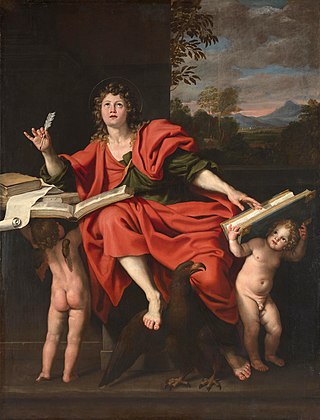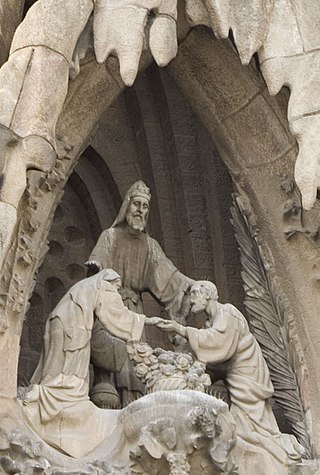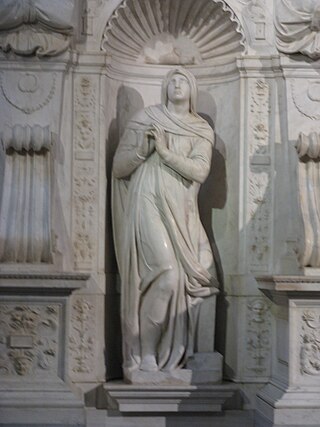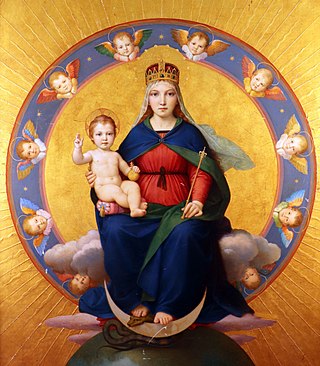Related Research Articles

The Book of Revelation or Book of the Apocalypse is the final book of the New Testament. Written in Koine Greek, its title is derived from the first word of the text: apokalypsis, meaning 'unveiling' or 'revelation'. The Book of Revelation is the only apocalyptic book in the New Testament canon. It occupies a central place in Christian eschatology.

The Assumption of Mary is one of the four Marian dogmas of the Catholic Church. Pope Pius XII defined it on 1 November 1950 in his apostolic constitution Munificentissimus Deus as follows:
We pronounce, declare, and define it to be a divinely revealed dogma: that the Immaculate Mother of God, the ever-Virgin Mary, having completed the course of her earthly life, was assumed body and soul into heavenly glory.
The Sanctus is a hymn in Christian liturgy. It may also be called the epinikios hymnos when referring to the Greek rendition and parts of it are sometimes called "Benedictus". Tersanctus is another, rarer name for the Sanctus. The same name is sometimes used for the Trisagion.

Matthew 1:19 is the nineteenth verse of the first chapter in the Gospel of Matthew in the New Testament. It is part of the description of the events surrounding the birth of Jesus. In the previous verse, Joseph has found Mary to be pregnant, and in this verse he considers leaving her.
Matthew 1:23 is the 23rd verse of the first chapter in the Gospel of Matthew in the New Testament. Joseph has just been informed of the nature of Jesus by an angel and in this verse the author of Matthew relates this to a quote from the Old Testament.

Matthew 2:18 is the eighteenth verse of the second chapter of the Gospel of Matthew in the New Testament. Herod has ordered the Massacre of the Innocents and this verse quotes from the Book of Jeremiah to show that this event was predicted by the prophets.

Matthew 27:55–56 are the fifty-sixth and fifty-seventh verses of the twenty-seventh chapter of the Gospel of Matthew in the New Testament. The crucifixion and death of Jesus have just occurred, and these verses make note of a group of women who were present at that event.
Matthew 15:28 is a verse in the fifteenth chapter of the Gospel of Matthew in the New Testament.

The Woman of the Apocalypse is a figure–often considered to be a reference to the Virgin Mary in Catholic theology–described in Chapter 12 of the Book of Revelation.

Revelation 1 is the first chapter of the Book of Revelation or the Apocalypse of John in the New Testament of the Christian Bible. The book is traditionally attributed to John the Apostle, but the precise identity of the author is a point of academic debate. This chapter contains the prologue of the book, followed by the vision and commission of John.

The New Eve is a devotional title for Mary, the mother of Jesus. Since the second century, numerous Eastern and Western Church fathers have expressed this doctrinal idea as an analogy to the biblical concept of the New Adam. Mary's unique and necessary participation in the economy of salvation is expressed in the doctrine, particularly her faith at the annunciation of the archangel Gabriel, which facilitates the incarnation of Jesus Christ and human redemption.

Revelation 12 is the twelfth chapter of the Book of Revelation or the Apocalypse of John in the New Testament of the Christian Bible. The book is traditionally attributed to John the Apostle, but the precise identity of the author remains a point of academic debate. This chapter contains the accounts about the woman, the dragon, and the child, followed by the war between Michael and the dragon, then the appearance of the monster from the sea. William Robertson Nicoll, a Scottish Free Church minister, suggests that in this chapter the writer has created a Christianised version of a Jewish source which "described the birth of the Messiah in terms borrowed from ... cosmological myths [such as] that of the conflict between the sun-god and the dragon of darkness and the deep".
The Ancient Greek noun tektōn (τέκτων) is a common term for an artisan/craftsman, in particular a carpenter, woodworker, or builder. The term is frequently contrasted with an ironworker, or smith (χαλκεύς) and stone-worker or mason.

Revelation 18 is the eighteenth chapter of the Book of Revelation or the Apocalypse of John in the New Testament of the Christian Bible. The book is traditionally attributed to John the Apostle, but the precise identity of the author remains a point of academic debate. This chapter describes the fall of Babylon the Great.
Isaiah 40 is the fortieth chapter of the Book of Isaiah in the Hebrew Bible or the Old Testament of the Christian Bible, and the first chapter of the section known as "Deutero-Isaiah", dating from the time of the Israelites' exile in Babylon. This book contains the prophecies attributed to the prophet Isaiah, and is one of the Books of the Prophets. Parts of this chapter are cited in all four canonical Gospels of the New Testament.
Isaiah 11 is the eleventh chapter of the Book of Isaiah in the Hebrew Bible or the Old Testament of the Christian Bible. This book contains prophesies attributed to the prophet Isaiah. This chapter can be divided into two main parts, verses 1–9 and verses 11–16, with verse 10 as a connecting statement between them. The New International Version entitles the chapter "The Branch from Jesse".
Isaiah 25 is the twenty-fifth chapter of the Book of Isaiah in the Hebrew Bible or the Old Testament of the Christian Bible. This book contains the prophecies attributed to the prophet Isaiah, and is one of the Books of the Prophets. Chapters 24-27 of Isaiah constitute one continuous poetical prophecy, sometimes called the "Isaiah Apocalypse".
Isaiah 29 is the twenty-ninth chapter of the Book of Isaiah in the Hebrew Bible or the Old Testament of the Christian Bible. This book contains the prophecies attributed to the prophet Isaiah, and is one of the Book of the Prophets. The Jerusalem Bible groups chapters 28-35 together as a collection of "poems on Israel and Judah".
Matthew 14:9-11 is a verse in the fourteenth chapter of the Gospel of Matthew in the New Testament.
Textual variants in the Hebrew Bible manuscripts arise when a copyist makes deliberate or inadvertent alterations to the text that is being reproduced. Textual criticism of the Hebrew Bible has included study of its textual variants.
References
- ↑ Revelation 12:1 KJV
- ↑ Revelation 12:1 RSV
- ↑ Barnes, Albert, Barnes' Notes on Revelation 12, accessed 8 November 2018
- ↑ Boyd Carpenter, W., Commentary on Revelation, chapter 12, accessed 7 November 2018
- ↑ Saunder, Rev. William. "Woman Clothed with the Sun", Arlington Catholic Herald, 2004. Catholic Education Resource Center. Retrieved July 6, 2011 Archived July 13, 2013, at the Wayback Machine